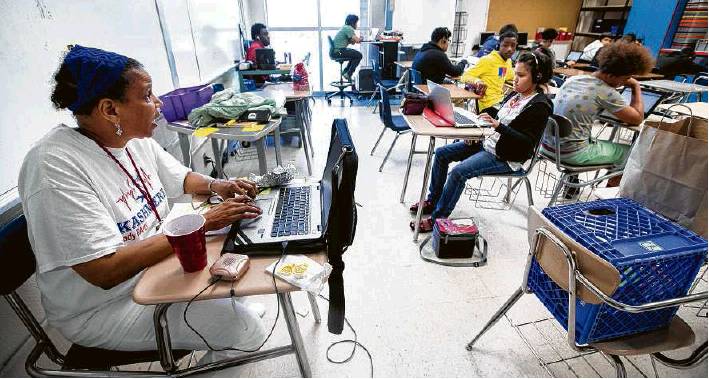Schools OK’d to meet in summer
CHOICES: Decision to reopen up to leaders
By Jacob Carpenter and Shelby Webb STAFF WRITERS
Texas education leaders can reopen campuses for in-person summer school starting June 1, as long as they institute safety protocols that include limiting the number of people in classrooms and checking students’ body temperature each day, state officials said Monday.
The announcement by Gov. Greg Abbott and Texas Education Agency leaders marks the first possible return to schools for some of the state’s 5 million-plus students, who have been forced to stay home since mid-March due to the novel coronavirus pandemic. State officials are not mandating that schools resume face-to-face instruction, leaving that decision to local leaders.
“Increasingly, there are cities and countries around the world where schools have reopened and social distancing practices are being maintained successfully,” TEA officials said in a statement. “Our educators here in Texas have accomplished amazing things in the last two months, and it’s clear that with appropriate planning, the safety of our students, teachers and staff can be maintained.”
Several local school districts, including Houston, Fort Bend and Aldine ISDs, are exploring the potential for bringing a small percentage of their highest-need students onto campus, while other districts are planning to hold all summer school classes online.
In Houston ISD, the state’s largest district, Interim Superintendent Grenita Lathan said the majority of summer school instruction will take place virtually. However, administrators are “planning for the possibility of some face-to-face instruction over the summer,” with students receiving special education services and children needing intensive academic supports “at the forefront of these discussions.”
“We would prefer to provide face-to-face instruction to our students, but only if we’re absolutely confident that it can be done safely,” Lathan said in a statement. She did not specify when a decision on in-person classes would be made.
The state announcement lands as some parents and school employees continue to fear the potential public health implications of reopening schools. While children suffer complications from COVID-19 at low rates, health and education officials fret about their ability to spread the virus to more vulnerable adults, such as teachers and relatives.
At the same time, educators widely agree that children are falling behind academically, missing a key time in their social development and suffering more trauma at home.
Texas’ number of coronavirusrelated deaths — about 1,350 — and hospitalization rates remain relatively low compared to other states, though the number of confirmed COVID-19 cases has slightly increased in the past two weeks as testing has expanded.
With some schools poised to reopen, Texas Education Agency officials released a six-page document Monday outlining requirements and recommendations for operating buildings amid the pandemic. Among them:
• Summer school must be optional for students.
•Classrooms should hold no more than 11 people, unless there is space to set apart groups of 11 by 30 feet.
•Desks should be spaced at least 6 feet apart.
• Staff should conduct temperature checks of students at the beginning of each day, if possible.
• School leaders should require students to use hand sanitizer before entering buildings, engage in 20 seconds of supervised hand-washing at least twice a day and have access to sanitizer in classrooms.
• School leaders should consider having all employees wear face masks, as well as students “for whom it is developmentally appropriate.”
• If a staff member or student tests positive for COVID-19, prepare to close one classroom, multiple classrooms or an entire school for two weeks, depending on the infected individual’s level of contact with other people.
Houston-area education leaders have spent the past several weeks preparing for Abbott’s announcement Monday, hopeful that some form of in-person classes could resume this summer.
In Aldine ISD, the Houston area’s fifth-largest district, school leaders are aiming for a July 1 return to in-person classes, Communications Director Sheleah Reed said. District officials could not reinvent their safety protocols and change operations to maintain social distancing in just two weeks, Reed said. When summer school does begin there, staff will focus on targeted groups of students, including children with disabilities or those at risk of being held back.
“We’re still talking through what July looks like,” Reed said. “It’s ahard reset. You’re essentially rebuilding the way the school building looks.”
Officials in Cy-Fair ISD, the region’s second-largest district, said Monday they are “currently evaluating the recent guidance.” In Katy ISD, the region’s third-largest district, administrators still plan to hold virtual summer school for now.
Abbott did not comment Monday on the outlook for resuming face-to-face classes in August. Many districts are preparing for the possibility ofhosting a mix of in-person and virtual classes, with students traveling to campuses for part of the week and staying home the rest of the time.
Alief ISD Superintendent HD Chambers said his district is using the newly released summer school guidelines as a potential road map for operating schools in 2020-21. Alief does not plan to open campuses for summer school, but district officials are looking at beginning the upcoming school year several days earlier than the original Aug. 17 start date.
If state guidance continues to call for limiting classroom capacity to 11 people, campuses could have to divide students into shifts to maintain social distancing, Chambers said. For example, he said, half of the students in a school could have in-person instruction in the morning and participate in remote learning in the afternoon, when a second group of students would be brought to the campus.
The change would impact “every aspect of school you can think of,” including busing, teacher planning days and the academic calendar, Chambers said.
“We need to be able to give our teachers and campus leaders time to react,” Chambers said. “But the earlier we can start and everyone feels safe and secure with the protocols, the better our students will be and better teachers will be able to put together a meaningful plan.” jacob.carpenter@chron.com shelby.webb@chron.com
